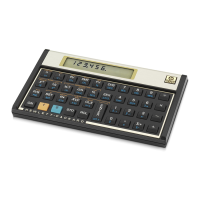12 Making Financial Calculations Easy
The calendar functions and nearly all of the financial functions take some
time to produce an answer. (This is typically just a few seconds, but the
¼, !, L, and S functions could require a half-minute or more.)
During these calculations, the word running flashes in the display to let
you know that the calculator is running.
Example 2: We now need to determine how to accumulate the required deposit
by the time your daughter enters college 14 years from now. Let’s say that she
has a paid-up $5,000 insurance policy that pays 5.35% annually, compounded
semiannually. How much would it be worth by the time she enters college?
In this example, we need to calculate FV, the future value.
Example 3: The preceding example showed that the insurance policy will
provide about half the required amount. An additional amount must be set aside
to provide the balance (21,396.61 – 10,470.85 = 10,925.76). Suppose you make
monthly payments, beginning at the end of next month, into an account that pays
Keystrokes Display
fCLEARHf2
0.00
Clears previous data inside the
calculator and sets display to show
two decimal places.
4gA
48.00
Calculates and stores the number of
compounding periods.
6gC
0.50
Calculates and stores the periodic
interest rate.
500P
500.00
Stores periodic payment amount.
g×
500.00
Sets payment mode to Begin.
$
–21,396.61
Amount required to be deposited.
a
a Don’t be concerned now about the minus sign in the display. That and other details will
be explained in Section 3.
Keystrokes (RPN mode) Display
fCLEARG
–21,396.61
Clears previous financial data
inside the calculator.
14\2§w
28.00
Calculates and stores the number of
compounding periods.
5.35\2z¼
2.68
Calculates and stores the periodic
interest rate.
5000Þ$
–5000.00
Stores the present value of the
policy.
M
10,470.85
Value of policy in 14 years.

